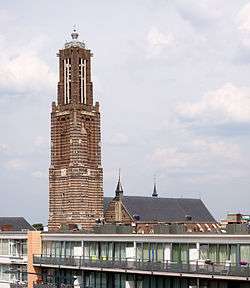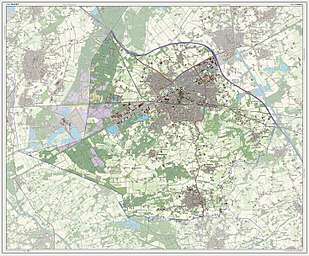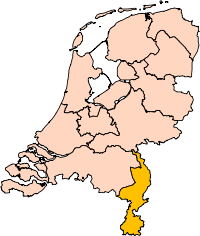Weert
| Weert Wieërt | |||
|---|---|---|---|
| Municipality | |||
 Saint Martin church in Weert | |||
| |||
.svg.png) Location in Limburg | |||
| Coordinates: 51°15′N 5°42′E / 51.250°N 5.700°ECoordinates: 51°15′N 5°42′E / 51.250°N 5.700°E | |||
| Country | Netherlands | ||
| Province | Limburg | ||
| Government[1] | |||
| • Body | Municipal council | ||
| • Mayor | Jos Heijmans (D66) | ||
| Area[2] | |||
| • Total | 105.52 km2 (40.74 sq mi) | ||
| • Land | 104.52 km2 (40.36 sq mi) | ||
| • Water | 1.00 km2 (0.39 sq mi) | ||
| Elevation[3] | 35 m (115 ft) | ||
| Population (August 2017)[4] | |||
| • Total | 49,651 | ||
| • Density | 475/km2 (1,230/sq mi) | ||
| Demonym(s) | Weertenaar, Weerter | ||
| Time zone | UTC+1 (CET) | ||
| • Summer (DST) | UTC+2 (CEST) | ||
| Postcode | 6000–6006, 6039 | ||
| Area code | 0495 | ||
| Website |
www | ||

Weert (Dutch pronunciation: [ʋeːrt] (![]()
Population centres
- Altweerterheide
- Boshoven
- Leuken
- Laar
- Stramproy
- Swartbroek
- Tungelroy
- Groenewoud
- Biest
- Molenakker
- Laarveld
- Moesel
- Weert
The city of Weert
Weert received city rights in 1414.
Weert is known for it's huge indoor shoppingcenter called 'De Munt', one of the largest in the south of the Netherlands. The inner city has a lot of squares with cosy restaurants and terraces. Almost all famous shopping brands are located in the city of Weert.
Furthermore Weert is known for it's large indoor and outdoor swimmingpool 'De Ijzerenman', with slides, 5 swimmingpools and a lake.
Demographics
Languages
- Dutch in Weert is often spoken with a distinctive Limburgish accent, which should not be confused with the Limburgish language.
- Limburgish (or Limburgian) is the overlapping term of the tonal dialects spoken in the Belgian and Dutch provinces of Limburg. The Weert dialect is only one of many variants of Limburgish.[5]
Transport
Railway station: Weert
Notable residents
- Frans Weekers (born 1967), Dutch Politician
- Jan Dibbets (born 1941), conceptual artist
- Ton van Loon (born 1956), military commander
- Lucas Hüsgen (born 1960), writer
- Gonnelien Rothenberger (born 1968), equestrian
- Sjeng Schalken (born 1976), tennis player
- Elbekay Bouchiba (born 1978), footballer
- Frank van Kouwen (born 1980), footballer
- Bjorn Hoeben (born 1980), cyclist
- Olivier Tielemans (born 1984), race car driver
- Pieter Custers (born 1984), archer
- Steef Nieuwendaal (born 1986), footballer
Sister cities
Weert is twinned with the following cities:
.svg.png)
References
- ↑ "A.A.M.M. (Jos) Heijmans" (in Dutch). Gemeente Weert. Retrieved 4 December 2013.
- ↑ "Kerncijfers wijken en buurten" [Key figures for neighbourhoods]. CBS Statline (in Dutch). CBS. 2 July 2013. Retrieved 12 March 2014.
- ↑ "Postcodetool for 6001GJ". Actueel Hoogtebestand Nederland (in Dutch). Het Waterschapshuis. Retrieved 4 December 2013.
- ↑ "Bevolkingsontwikkeling; regio per maand" [Population growth; regions per month]. CBS Statline (in Dutch). CBS. 27 October 2017. Retrieved 27 October 2017.
- ↑ Heijmans, Linda; Gussenhoven, Carlos (1998), "The Dutch dialect of Weert" (PDF), Journal of the International Phonetic Association, 28: 107, doi:10.1017/S0025100300006307
External links

- Official website (in Dutch)

